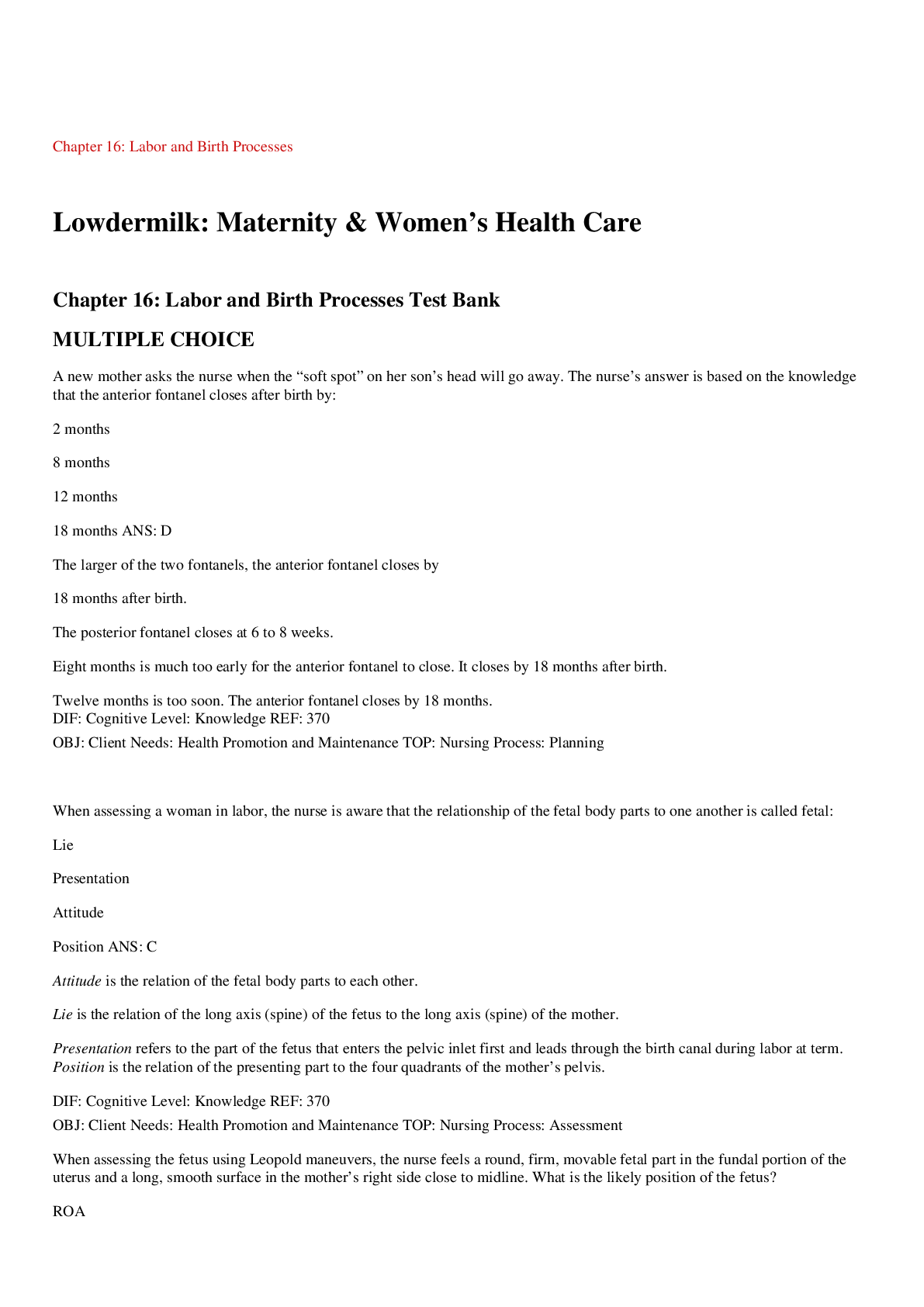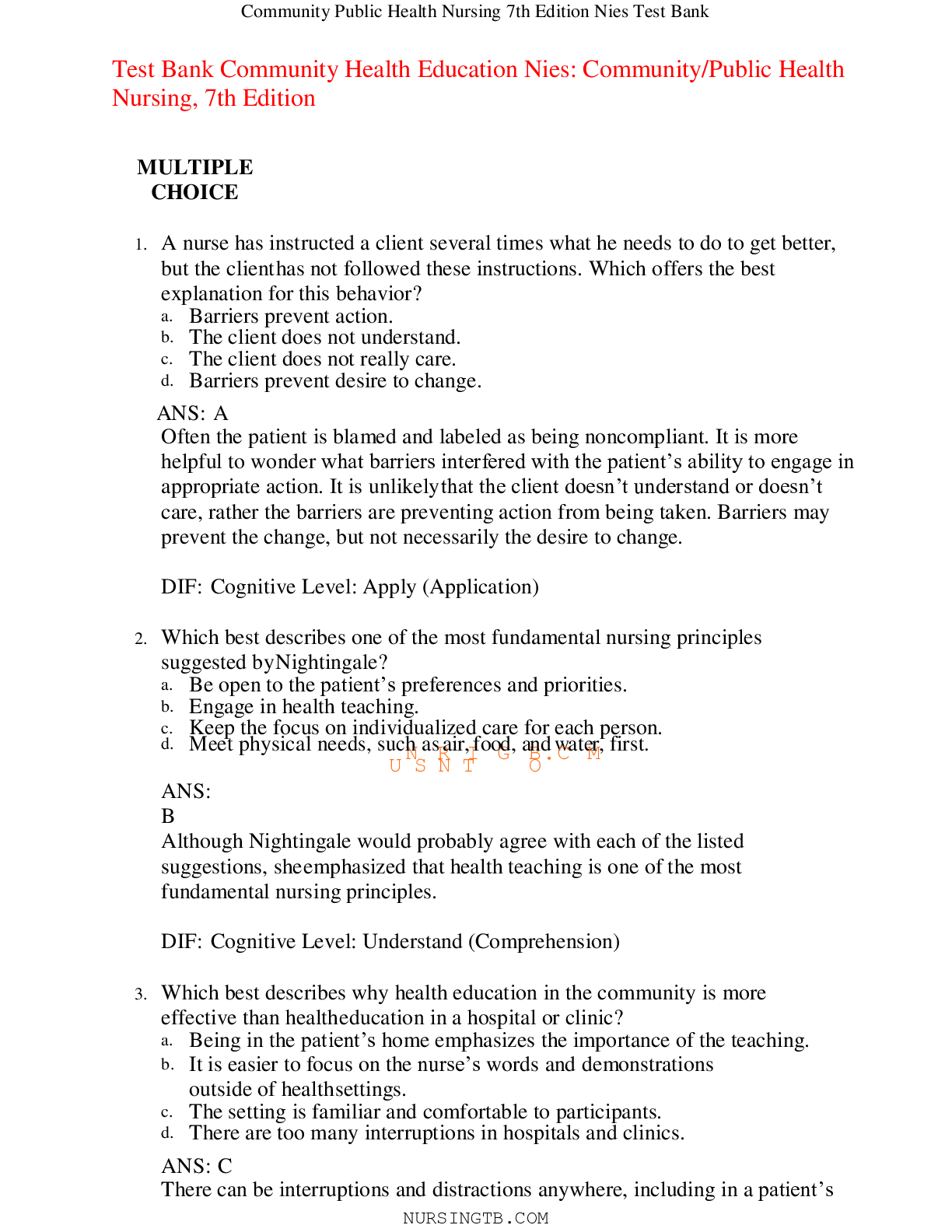*NURSING > TEST BANK > Test Bank NURS 2900 Complementary and Alternative Therapies,100% CORRECT (All)
Test Bank NURS 2900 Complementary and Alternative Therapies,100% CORRECT
Document Content and Description Below
Test Bank NURS 2900 Complementary and Alternative Therapies 1. Which type of therapy is speculated to affect the ion exchange of electrolytes, such as calcium, sodium, and potassium? A) Electromagne... tic therapy B) Shiatsu C) Hypnosis D) Yoga Ans: A Feedback: Electromagnetic therapy is speculated to influence ion exchange of electrolytes, such as calcium, sodium, and potassium. Shiatsu uses acupoints, and yoga uses exercises for therapy. Hypnosis is not known to affect ions in the body. 2. Chiropractors treat disorders by which of the following methods? A) Applying force to a specific location B) Massaging the area to encourage circulation C) Manipulating the spine to align vertebrae D) Channeling the universal energy Ans: C Feedback: According to chiropractic theory, misalignment of the spinal vertebrae changes activities of nerves that control body functions in distant organs. This may lead to diseases. Spine manipulation treats the disorders by correcting the alignment of the vertebrae. Applying force to a specific location is the method of acupressure and not chiropractic. Massage improves circulation, but this is not the main job of the chiropractor. Channeling universal energy happens only in Reiki. 3. Which of the following complementary and alternative therapies uses 7,000 nerve endings to improve the body's ability to facilitate natural healing? A) Reflexology B) Magnetism C) Acupuncture D) Chiropractic Ans: A Feedback: Practitioners of reflexology claim that reflex centers in the extremities have more than 7,000 nerve endings connected to the body organs and tissues. When pressure is applied to one reflex center, the impulse travels to the spinal cord and brain. This reconditioning of the neural reflex facilitates natural healing. Magnetism seeks to cure by influencing the natural magnetic field of body cells. Acupuncture is a procedure used in or adapted from Chinese medical practice in which specific body areas are pierced with fine needles for therapeutic purposes. Chiropractors manipulate the spine to correct its misalignment. 4.A patient is entering the clinic today requesting a method that has few physical risks, can be taught easily, and has provided evidence of positive effects. The patient is requesting a conventional method. What type of treatment would you advise them of? A) Reflexology B) Magnetism C) Acupuncture D) Biofeedback Ans: D Feedback: Biofeedback is a mind–body medical technique. Mind–body interventions, such as imagery, humor, and hypnosis, have few physical risks, are easy to teach, and have proved to be effective. Although reflexology, magnetism, and acupuncture have also found acceptance, they lack these attributes, and questions remain about their effectiveness. 5. Although 25% of prescription drugs are derived from plants, interest in self-treatment using herbs has been on the rise. Which of the following is the reason for this? A) Prescribed drugs are subjected to federal regulations. B) Herbs are easily available. C) There are differences in molecular structure between the source plant and the synthesized drug. D) Using only parts of a plant may not have the same effects as using the whole plant. Ans: D Feedback: Herbalists argue that consuming the whole plant has different effects. Prescribed drugs contain only one or two extracts or synthetic substances that match the molecular structure of the source plant. Therefore, in many cases, the molecular structure may be the same. Regulations are relevant to producers of drugs or herbal products, not the users. 6. In which of the following therapies is it believed that the practitioner gathers knowledge about the disease and its cure from a higher power? A) Herbal therapy B) Ayurveda C) Native American system D) Chinese medicine Ans: C Feedback: In the Native American system of medicine, the shaman or medicine man or woman goes into a trance and communicates with a higher power to gather knowledge about the disease and its remedy. Herbal therapy uses herbs with medicinal value, and Ayurveda and Chinese medicine do not involve shamans and such spiritual practices. 7.A client is taking gingko to improve her memory. In the teaching plan regarding this herb, the nurse should include which of the following? A) It may raise blood pressure. B) Avoid this herb if allergic to plants. C) There is a possible sensitivity to light. D) Use caution if taking aspirin. Ans: D Feedback: Clients should be advised to use caution if taking aspirin in conjunction with gingko. Ginseng may raise blood pressure. Avoid echinacea if allergic to plants in the daisy family. Taking St. John's wort may cause sensitivity to light. 8.Which of the following is an important benefit of incorporating laughter therapeutically? A) Increases cortisol levels B) Increases the number of white blood cells C) Blocks the release of endorphins D) Stimulates the immune system Ans: B Feedback: Laughter stimulates the immune system by increasing the number of white blood cells and lowering cortisol, which suppresses immune function. 9.A patient is suffering from stress and tension of the neck and muscles. What manipulative therapy would you use to apply pressure and movement to soft tissues? A) Chiropractic B) Shiatsu C) Massage therapy D) Yoga Ans: C Feedback: Massage therapy involves applying pressure and movement to stretch and knead soft body tissues. Chiropractic theory proposes that subluxation (misalignment) of the spinal vertebrae alters nerve activities that regulate body functions in distant organs. Shiatsu is similar to acupressure and acupuncture. Yoga does not involve applying pressure to soft tissues. 10.Proponents of which type of complementary health practice believe that reprogramming the neural reflex improves the body's ability to facilitate natural healing? A) Shiatsu B) Reflexology C) Yoga D) Chiropractic Ans: B Feedback: Reflexologists believe that reconditioning or reprogramming the neural reflex improves the body's ability to facilitate natural healing. Yoga, shiatsu, and chiropractic do not use this type of healing. 11.A client with hyperlipidemia is taking niacinamide (niacin). The nurse understands this to be which type of treatment? A) Herbal therapy B) Complementary therapy C) Alternative therapy D) Conventional therapy Ans: C Feedback: Niacin is a biologically based therapy (vitamin) that can assist in lowering cholesterol levels. Biologically based practices used alone are considered alternative therapy. Niacin would not be considered conventional in the treatment of hyperlipidemia and unless used in conjunction with a prescription drug would not be considered complementary. Niacin is not an herbal preparation. 12.A client asks the nurse if watching funny videos can help in the treatment of cancer. Which is the best response from the nurse? A) “Visualizing your body fighting the cancer can be helpful.” B) “Laughter can stimulate your immune system.” C) “Laughing is better than crying.” D) “Use of humor is an approved form of cancer treatment.” Ans: B Feedback: Laughter stimulates the immune system by increasing the number of WBCs and suppressing the cortisol levels. Visualizing the fighting of cancer is imagery, not humor therapy. Use of humor is an optional mind–body therapy not an approved evidence-based form of cancer treatment. 13. Which statement by the nurse best supports an understanding of complementary and/or alternative therapies in the treatment of clients? A) “Alternative therapies are mainstay to conventional medical care.” B) “Complementary therapies should be avoided in advanced disease.” C) “Complementary therapies are evidence-based in theory.” D) “Alternative and complementary therapies are sensitive to culture and tradition.” Ans: D Feedback: Complementary and alternative therapies are sensitive to culture and tradition and can be used in conjunction with, or independent of, conventional therapies. In advanced disease processes, complementary therapies can assist with comfort measures for the client. 14. The nurse understands that offering chaplain services in the acute care facility supports which healing concept? A) Cure for disease B) Relief for the hopeless C) Spiritual healing D) Body cleansing Ans: C Feedback: Chaplains provided spiritual support and prayer as forms of spiritual healing. No evidence supports prayer as a cure for disease but can bring comfort during hopeless situations. Body cleansing is a physical not spiritual event. 15. What is the best response by the nurse when explaining biofeedback to a client? A) “It is a spiritual practice that combines exercise with mental focus.” B) “It is beneficial in expressing feelings.” C) “It allows a reduction of symptoms through voluntary control measures.” D) “It requires the use of machines in a controlled environment.” Ans: C Feedback: Biofeedback is a technique in which an individual voluntarily controls physiologic function. Yoga is the spiritual practice that combines exercise with mental focus. Music and art are ways to express feelings. Initially, biofeedback uses a machine but eventually the client can alter physiologic response at will. 16.A client with multiple sclerosis (MS) reports an improvement of symptoms after apitherapy. The nurse knows that apitherapy falls under which category of treatment? A) Mind–body medicine B) Biologically based practices C) Manipulative and body-based therapies D) Energy medicine Ans: B Feedback: Apitherapy is the medicinal use of bee venom and falls under the category of biologically based practices. Mind–body, manipulative, and energy medicine are categories of complementary and alternative therapies but do not include apitherapy. 17.What is the primary reason the nurse needs to ascertain client use of vitamins and minerals and the dosage of each? A) Intake of vitamins and minerals through diet is more beneficial. B) Vitamin and minerals should be used as a complementary therapy. C) Recommended daily allowance (RDA) for each vitamin and mineral may vary with special populations. D) Vitamins and minerals are purchased over-the-counter (OTC) and no purchase record is maintained. Ans: C Feedback: Special populations (such as pregnant women, elderly, and people with certain medical problems) may have different RDA requirements and levels for toxicity. Answers A, B, and Dare all true statements but are not the primary reason for accurate information collection. 18.A client, who is taking a variety of herbal preparations, makes the following comment to the nurse: “Herbs are natural products and therefore safe.” Which is the best response by the nurse? A) “Just because a product is natural does not mean safe.” B) “If the manufacturer is reputable, the product is considered safe.” C) “Many herbs are safe, but serious effects can occur if mixed with prescribed drugs.” D) “The chemicals used when growing herbs can prove to be poisonous or toxic to people.” Ans: C Feedback: Herbal therapy is one of the greatest risk factors for adverse effects when combined with other conventional treatment such as drugs. The U.S. Food and Drug Administration (FDA) do not regulate herbals making natural not necessarily safe. The use of reputable manufacturers should be considered but again not a guarantee for safety. The process of growing and harvesting herbs is not regulated. 19.A client with stage II cancer has opted to use reflexology and herbal therapy for treatment. The nurse understands this treatment falls under which modality? A) Culture care B) Complementary therapy C) Integrative therapy D) Alternative therapy Ans: D Feedback: The use of reflexology and herbs is considered alternative therapy when not used in conjunction with conventional medicine. Integrative therapy would combine alternative, complementary, and conventional medicine. Culture care is the delivery of care as sensitive to the culture and ethnic traditions of a client. 20.A client with arthritis finds relief of pain in the practice of tai chi, acupuncture, and massage. The nurse understands this medical system approach to originate from which culture? A) Ayurvedic medicine B) Western medicine C) Chinese medicine D) Native American medicine Ans: C Feedback: Balancing life's energy source through the use of tai chi, acupuncture, and massage are a part of Chinese Medicine. Ayurvedic medicine is practiced in India using fasting, yoga, cleansing, etc. Native American medicine uses shaman, symbols, and herbs in treatments. Western medicine is a form of conventional medicine. 21. Which nursing comment would best describe the conventional medical system to a client? A) “Focus is on treating illness or injury.” B) “Sensitive to cultural traditions.” C) “Health results from harmony between person and universe.” D) “Approach is based on traditional use.” Ans: A Feedback: Conventional medical systems are based on scientific approach for treating illness or injury. Alternative medical systems are sensitive to culture and harmony between person and universe, which uses a more traditional approach. 22. Body-based therapy that uses manipulation can be delivered to the client via which forms of treatment? Select all that apply. A) Acupuncture B) Aromatherapy C) Tai chi D) Therapeutic touch E) Apitherapy F) Reflexology Ans: C, F Feedback: Tai chi and reflexology are manipulative body-based therapies. Acupuncture and therapeutic touch (Reiki) are energy therapies. Aromatherapy and apitherapy are biologically based practices. 23. In preparing the client for a reflexology consult, the nurse knows to allow full access to which body parts? A) Spine B) Face C) Lower extremities D) Abdomen Ans: C Feedback: Reflexology is the application of pressure to the foot. Manipulation of the spine is used in chiropractic care. Iridology looks into the eyes, and Reiki uses therapeutic touch to all seven chakras, which involve both head and trunk. 24.A client with fibromyalgia is using magnets as a form of complementary treatment. Which rationale given by the nurse best explains the physiologic principle of this technique? A) Free flow of energy B) Stimulates the release of endorphins C) A means of therapeutic touch D) No therapeutic effects with this technique Ans: B Feedback: Static magnet therapy can be used to affect the cell membrane and stimulate the release of endorphins. No scientific basis is available to support this effect, but people continue to claim benefits if nothing other than placebo effect. Free flow of energy refers to acupuncture, whereas therapeutic touch is associated with Reiki therapy. 25.Which key information can the nurse provide to the client, in regard to the health-related benefits of herbals and botanicals? Select all that apply. A) Certain herbs can interact with prescription drugs. B) No one should take herbs while acutely ill. C) Herbs can mimic disease symptoms. D) Not all herbs are safe. E) Herbs are regulated by the U.S. Food and Drug Administration. F) Only natural herbs are safe. Ans: A, D Feedback: Herbal therapy is one of the greatest risk factors for adverse effects when combined with other conventional drugs. Some herbs have been placed on the “unsafe” list due to known impurities and adverse effects, even though all herbs are considered natural. Herbs can be used to treat some acute illnesses. Herbal therapy is not regulated by the FDA. 26.A child recovering from a traumatic injury is encouraged to express feelings through pictures. The nurse recognizes this as which type of therapy? A) Music therapy B) Relaxation therapy C) Imagery D) Mind–body therapy Ans: D Feedback: Art, music, imagery, and relaxation therapy are all mind–body interventions. 27. When the nurse is assisting the client in the selection of complementary therapies, which of the following factors is most important to consider? A) Supporting the client's choice at all costs B) Evidence-based support C) Certification of the therapist D) Cultural beliefs of the client Ans: D Feedback: What constitutes health and illness is dependent on the social, education, and spiritual differences between cultures. Nurses should be supportive of client's choices as long as they are not potentially harmful. Not all therapies have extensive research or evidence to support use so benefits, and risks need to be reviewed on an individual basis. The use of therapists who are certified or well established should be a consideration. 28. When the views of the nurse and client differ in regard to complementary therapies, what is the best action taken by the charge nurse? A) Have the nurse attend cultural care classes. B) Counsel the nurse to understand her differences in opinion. C) Encourage the nurse to support the client. D) Maintain the assignment as posted. Ans: B Feedback: It is important for the nurse to respect and advocate for the client even when cultures or choice of therapies differ. When the nurse is unable to support the client in this process, due to culture or religious concerns, the assignment should be altered. Opportunities to share or attend culture care classes should be offered to all staff. 29. The client asks the nurse to assist in the selection of complementary therapy. Which of the following should guide the nurse in this process? A) Comfort zone of the nurse B) First do no harm C) Reason for the treatment D) Knowledge of all nontraditional options Ans: B Feedback: The nurse should support the client in choice of therapy as long as there is no potential for harm. The nurse's comfort zone is not the focus of importance. The reason for the treatment is not as important as the desired outcome or goal. Gaining knowledge about complementary and alternative therapies is an important role of the nurse, but knowing about all options may not be realistic. 30. Which statement by the nurse provides the best description of homeopathic medicine? A) “Like cures, like in treatment of disease.” B) “Prevention is the key to good health.” C) “Opposites attract in keeping balance.” D) “A fight between body and spirit.” Ans: A Feedback: Homeopathy proposes that the remedy for an illness be one that produced the symptoms. Preventive care is naturopathic in nature. Chinese medicine deals with the yin and yang in keeping balance. Folk medicine deals with the struggle between body and spirit. 31.A cancer client considers traveling to Mexico to begin coffee enema therapy and asks the nurse for advice. Which is the best response by the nurse? A) “There are many unproven treatments for cancer. Let's discuss this with your doctor.” B) “That would be an expensive trip. Can you afford it?” C) “Maybe your doctor can order the coffee enemas to be given here.” D) “Sounds like a good option. How can I help you make the arrangements?” Ans: A Feedback: Nurses can play a pivotal role in assisting clients in therapy selection, but they need to be cognizant of realistic options choices that are legal, without false hope, and within the scope of practice for nurses. Although the trip could be expensive, this response is not therapeutic. For those techniques that are still investigational, the nurse should caution the client. 32.Following antibiotic treatment, the client has developed diarrhea. Which is an appropriate complementary treatment for the nurse to offer this client? A) Apples B) Peppermint C) Cultured yogurt D) Whole milk Ans: C Feedback: Cultured yogurt is a probiotic that can lower the frequency or duration of diarrhea. Apples do not assist in relieving diarrhea. Peppermint is helpful in decreasing nausea. Whole milk is not a probiotic unless it is acidophilus milk. 33.A client, who uses compresses to relieve hemorrhoid discomfort, asks the nurse for some witch hazel. Which is the best action of the nurse? A) Explain that witch hazel is not an available drug. B) Contact the physician for an order for Tucks hemorrhoid wipes. C) Have the family bring witch hazel from home. D) Set up a sitz bath for the client. Ans: B Feedback: Tucks hemorrhoid wipes contain witch hazel, an herbal supplement that helps to soothe the discomfort associated with this condition. It is not appropriate to ask family to bring OTC drugs into the facility. A sitz bath may be helpful in treating the symptoms but requires a physician's order and is not the complementary therapy requested by the client. 34. The client is presently taking a multivitamin and is considering adding mineral-rich (liquid vitamins) and eye health vitamins to the daily routine. Which is the best response by the nurse? A) “It is best to consume vitamins through a food source.” B) “Can you show me the vitamin containers so we can review them together?” C) “Some vitamins can have toxic effects.” D) “Are you having symptoms of night blindness?” Ans: B Feedback: Reviewing the vitamin containers will provide the nurse and client with information on the dose of vitamins and whether they fall within the RDA. This can also provide an opportunity for further teaching. Vitamins consumed in food sources are better than supplements, but this is not the best response. Fat-soluble vitamins can have toxic effects, but determining doses is a preventable measure. Vitamin A found in eye vitamin supplements is used to prevent night blindness but is not the best response for this client. 35. The nurse is concerned when the prothrombin time (PT) for a client receiving warfarin (Coumadin) is fluctuating beyond normal range. The nurse suspects which supplement to be the cause of this elevation? A) Garlic B) Saw palmetto C) Vitamin C D) Ginseng Ans: A Feedback: Combining garlic with other anticoagulants can prolong bleeding. Saw palmetto is used to treat enlarged prostate and has no effects on bleeding. Vitamin C is a water-soluble vitamin and can cause calculi formation. Ginseng is used to increase energy and can result in elevation of blood pressure. [Show More]
Last updated: 2 years ago
Preview 1 out of 22 pages
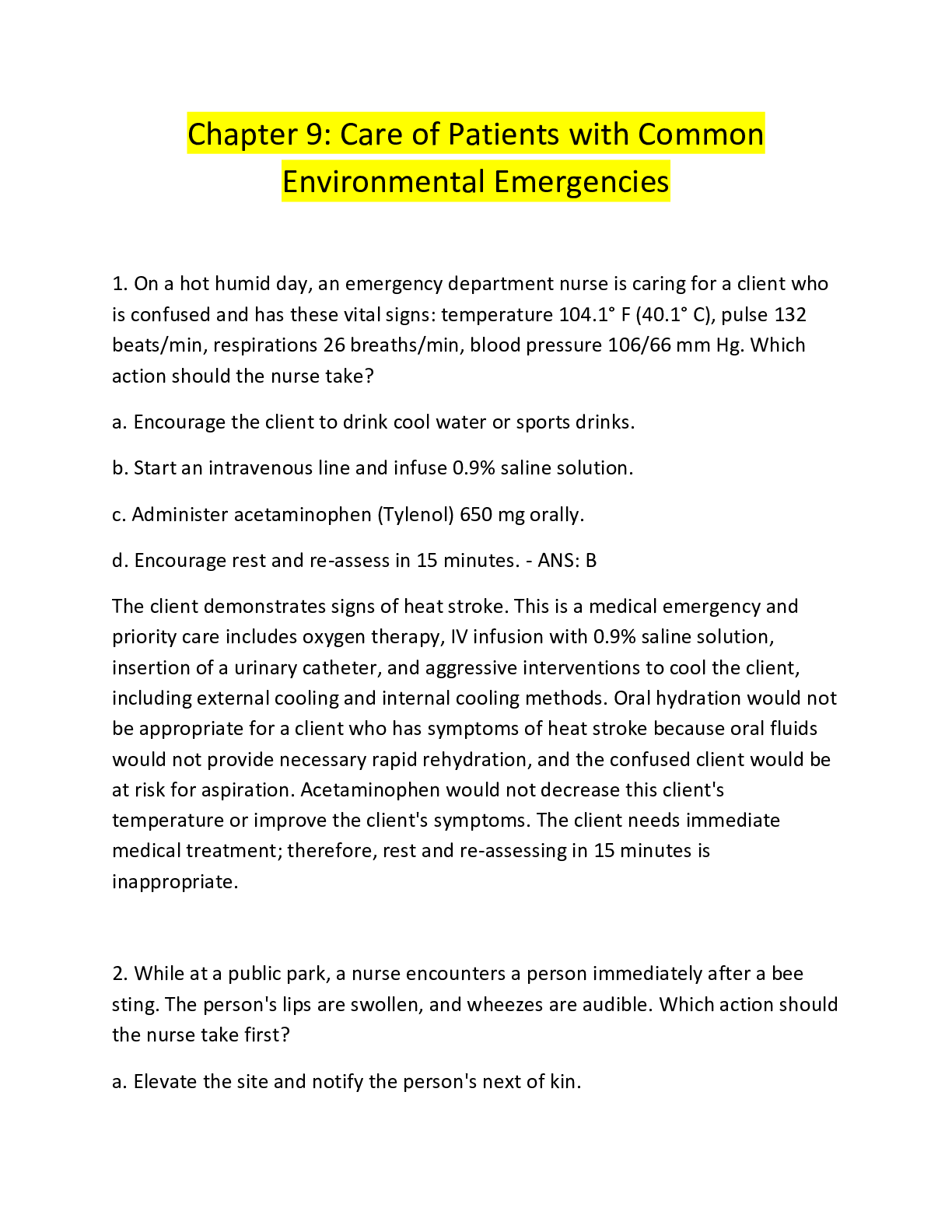
Buy this document to get the full access instantly
Instant Download Access after purchase
Buy NowInstant download
We Accept:

Reviews( 0 )
$16.00
Can't find what you want? Try our AI powered Search
Document information
Connected school, study & course
About the document
Uploaded On
Sep 22, 2022
Number of pages
22
Written in
Additional information
This document has been written for:
Uploaded
Sep 22, 2022
Downloads
0
Views
53


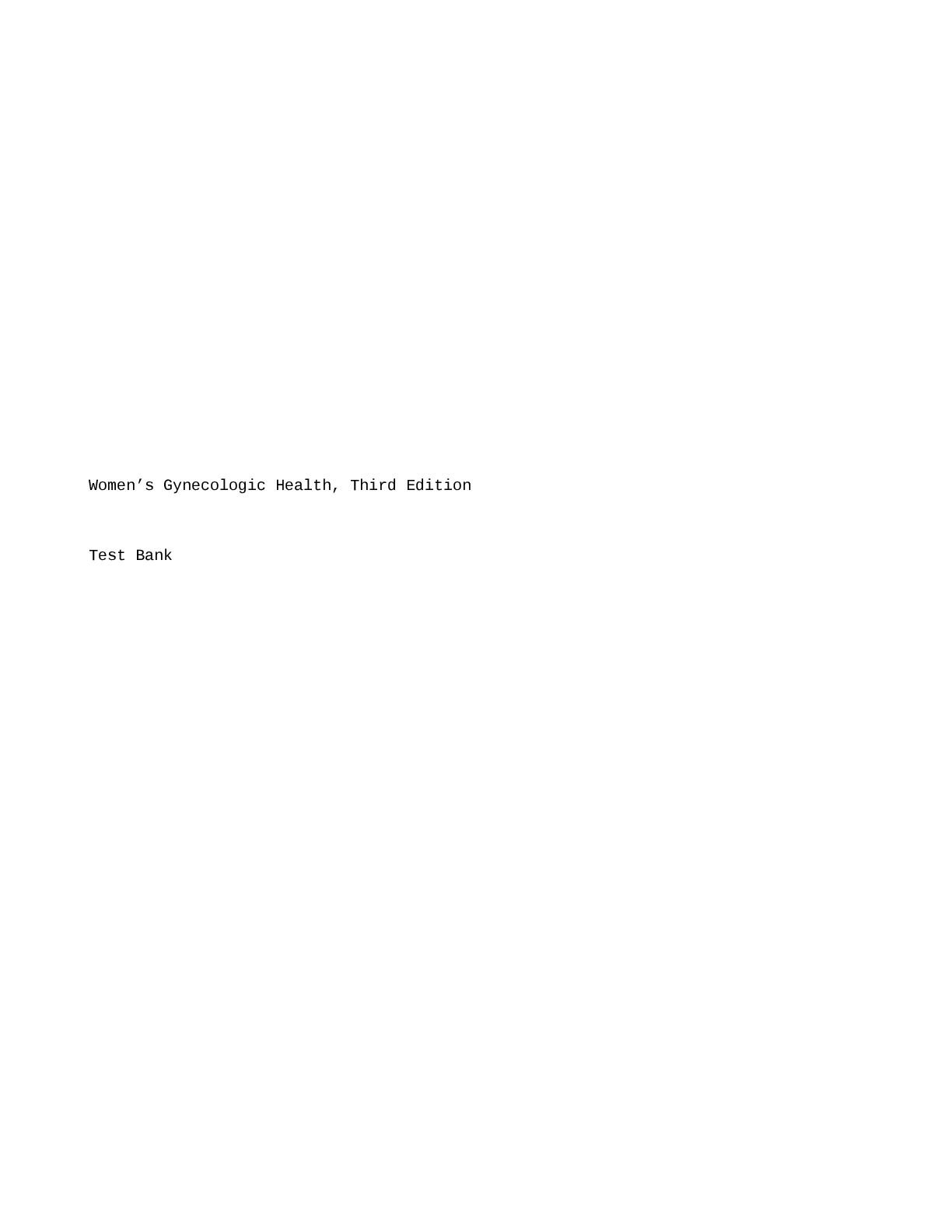

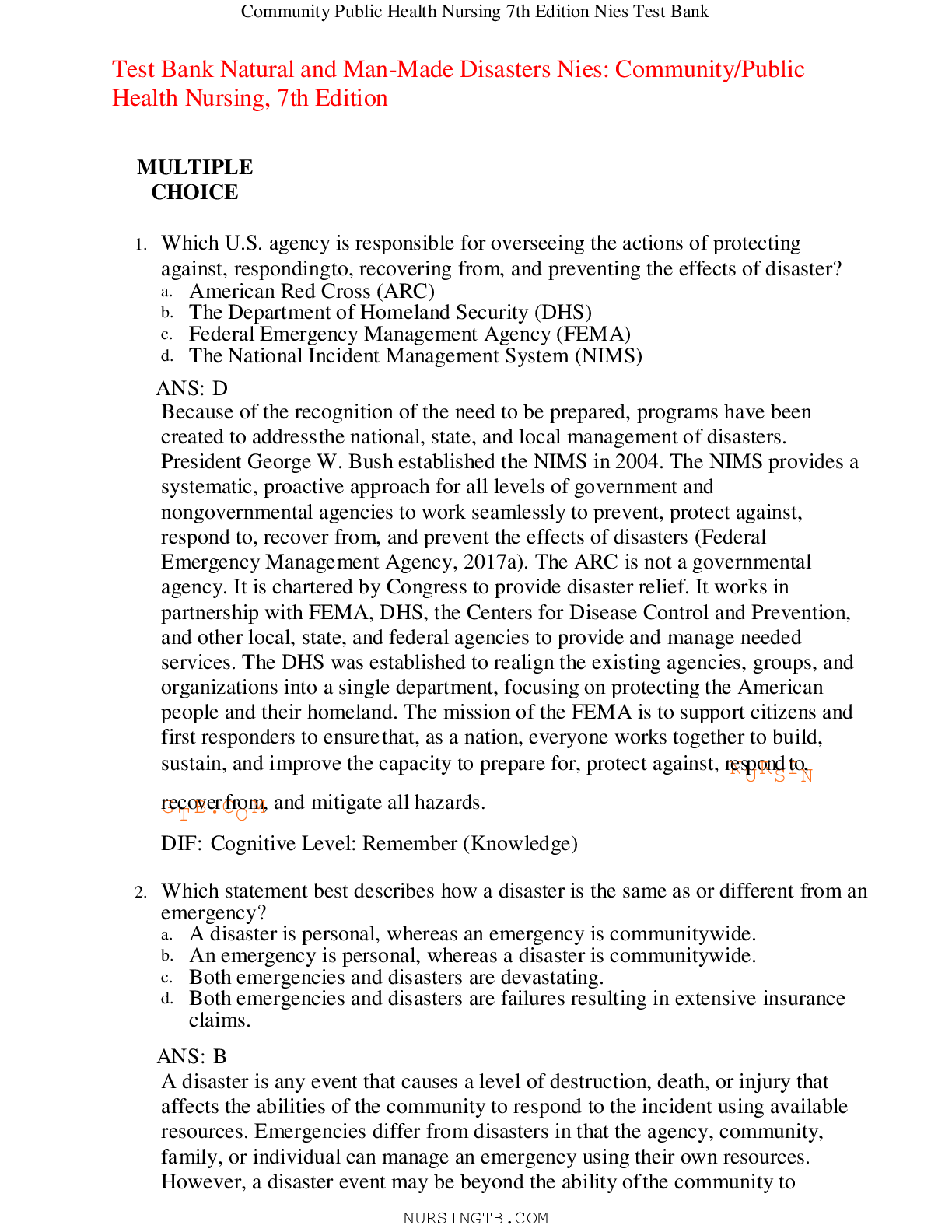

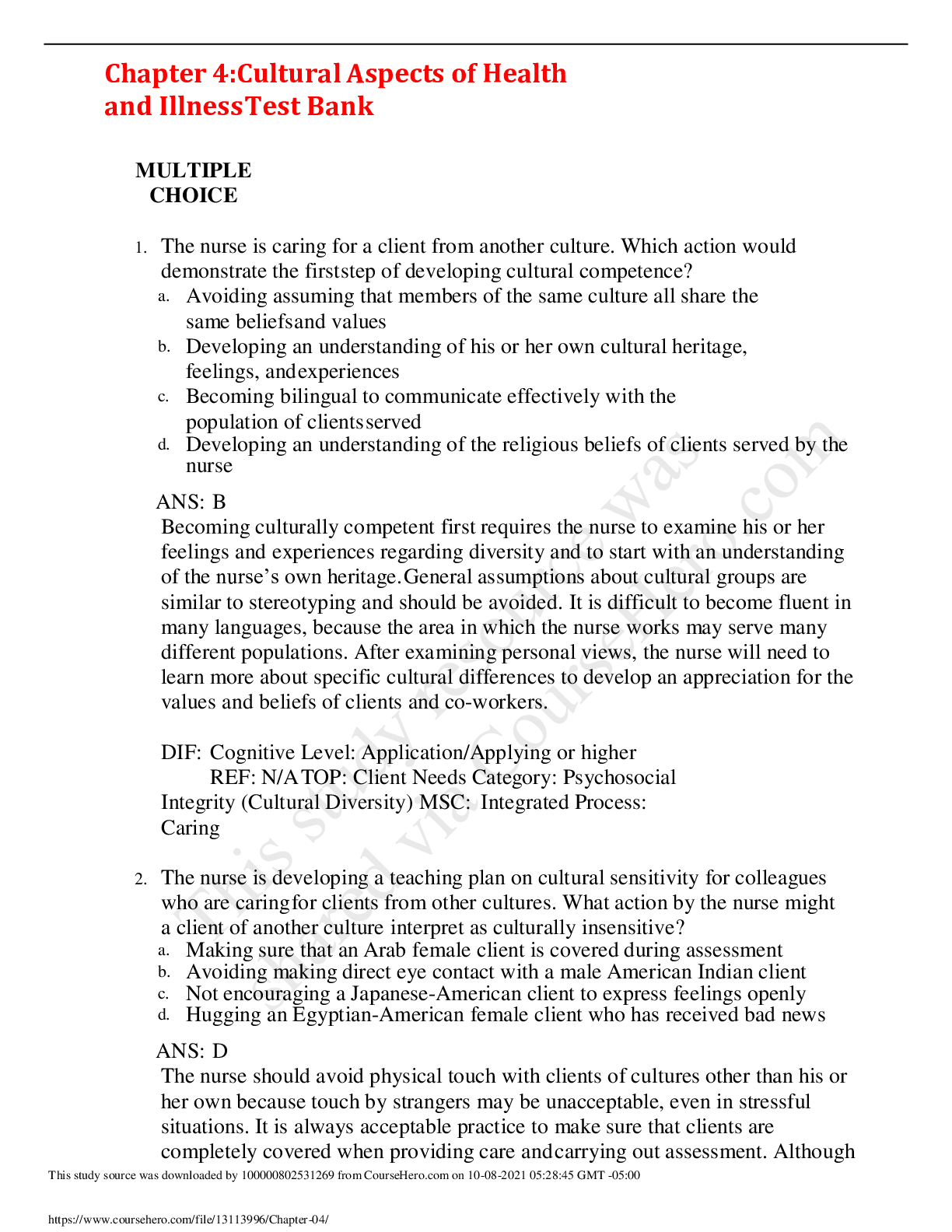


.png)
